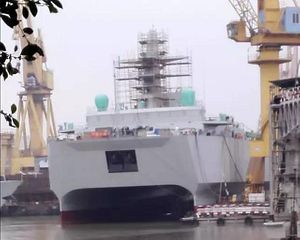China may be adding a potentially powerful new tool to its anti-submarine warfare capabilities. Photographs have circulated over the past week showing what appears to be a new Chinese ocean surveillance vessel being completed in southern China, possibly giving China a new long-range capability to detect submarines.
The vessel is a unique catamaran-type design known as Small Waterplane-Area Twin Hull (SWATH) being completed at a shipyard in Huangpu near Hong Kong that has built SWATH designs for the Chinese navy before. SWATH vessels are both extremely stable and extremely quiet, especially when outfitted with electric motors for propulsion. Their stability and quiet make them especially useful for hydrographic surveying and research utilizing sonar and other sensitive acoustic equipment, and for locating submarines.
While the photographs do not yet show any obvious equipment such as reels for towed sonar arrays, the vessel is almost certainly intended to support Chinese anti-submarine warfare operations to detect and track submarines. The Chinese vessel bears unmistakable resemblance to U.S. Navy Ocean Surveillance Ships, which are equipped with advanced sonar arrays to detect and track submarines at great ranges. These ships trail sensitive listening equipment on long cables that can pick up the sound of submarines traveling underwater and track their movement. Some can augment their passive listening arrays with low-frequency active arrays that send sound waves into the water to bounce off submerged submarine hulls to reveal their location.
The new Chinese vessel’s military role can also be inferred from the color it has been painted.
Naval vessels like supply ships, research vessels, or surveillance ships, are generally not armed and are considered “auxiliaries” instead of warships. In the U.S. Navy, auxiliaries are not even crewed by Navy personnel, but by civilian mariners. Auxiliaries that provide indirect support to fleet operations like oceanographic research or hydrographic surveys are usually painted white, while auxiliaries that directly support combat operations are generally painted gray like the warships whose missions they enable.
Other SWATH vessels operated by the Chinese Navy, like the Type-639, are listed as research or survey ships and are painted white. However, this new Chinese SWATH vessel is painted gray, implying that it will be providing direct warfighting support to the Chinese fleet, further evidence that it will have an anti-submarine warfare mission.
If so, it will be telling whether the vessel operates independently, or with warship escorts, indicating the response it expects from the United States. Chinese vessels routinely shadow U.S. surveillance ships and have subjected them repeatedly to harassment and intimidation, most famously in the 2009 USNS Impeccable incident, when Chinese ships and aircraft harassed it over several days, culminating in being repeatedly cut off by paramilitary trawlers that tried to damage its towed arrays.
But it will be most revealing where this new ship, and any subsequent units, operate, whether in or near Chinese waters, or in the vicinity of other countries’ submarine bases.
China objects to U.S. surveillance ships operating near their coast, asserting maximalist (and excessive) claims of sovereign rights beyond its territorial waters and airspace, as well as a restrictive (and minority) interpretation of the UN Law of the Sea’s prohibition against hostile military activities in other states’ exclusive economic zones.
Despite these legal interpretations and assertions, China has taken full advantage of the rights it attempts to restrict near its own shores when operating in other countries’ waters, such as when it sent a surveillance vessel to monitor a multinational exercise off the coast of Hawaii in 2014 and sailed a squadron of five warships through U.S. territorial waters in Alaska in 2015.
However, while China may be tempted to use this new surveillance vessel to monitor foreign submarine bases like the U.S. Naval base in Guam, geography may limit its utility far beyond China’s near seas.
Environmental impact reports published by the U.S. Navy reveal that its ocean surveillance ships operate almost exclusively in the Western Pacific, often within the first island chain, the string of islands stretching from Japan south through the Philippine archipelago that rings nearly the entire Chinese coastline. These island chains limit the routes that Chinese submarines can take to break out into the wider Western Pacific, simplifying the problem of trying to detect and track them. For China to similarly try to track foreign submarines approaching their shores, the reversed geography could be a complicating factor instead of simplifying one.
Nevertheless, China may already be preparing to hone its anti-submarine operations near strategic chokepoints. Reports that China may have been conducting underwater surveys of the Benham Rise east of the Philippines this past spring raised concerns that it was violating the Philippines’ economic rights in the area. But as I wrote at the time, Benham Rise also holds a strategic location near the approaches to the major route that U.S. ships and submarines would take to get from the Western Pacific ocean into the South China Sea, raising the possibility that the surveys were in support of submarine operations.
The United States views its advanced, ultra-quiet submarines as its principal asymmetric advantage over a potential adversary like China, where the necessity of operating near the Chinese mainland presents particular threats to surface ships, such as from its long-range anti-ship ballistic missiles. Hydrographic surveys near strategic chokepoints and this possible new ocean surveillance capability indicate that China is working to mitigate that advantage should it ever come to a clash with the United States.

































